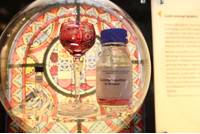Astronomy & Astrophysics has recently published the spectacular discovery of meteorite fragments 20 years after the corresponding bolide has been seen in the skies of the Czech Republic. This discovery was made possible by reanalysing the trajectory, which moved the impact line by 330 meters. Interestingly, the meteorites found on the ground are of different types, pointing to a parent asteroid of heterogeneous composition.

Image of Benešov bolide taken by the fish-eye guided camera at Ondřejov Observatory. Its apparent magnitude was -22 (6000 times brighter than the -12.6 apparent magnitude of the full Moon).
Collisions of meter-sized meteoroids with the Earth’s atmosphere are relatively rare, occurring about 40 times a year. They cause very spectacular events, known as superbolides. One of the best known such events, the Benešov bolide, occurred on May 7, 1991 at 23h 03m 46s UT over the Czech Republic. It was recorded during systematic photographic observations by the European Fireball Network and certainly ended in a multiple meteorite fall, but no meteorite was found in the weeks and years after the fall, despite many attempts.

First three Benešov meteorites found in April 2011, with metal detectors. From left to right: H5 chondrite of 1.56 g, LL3.5 chondrite of 7.72 g with achondrite clast, and LL3.5 chondrite of 1.99 g.
In February 2011, nearly 20 years after the event, P. Spurný and his colleagues (The team includes P. Spurný, J. Haloda, J. Borovička, L. Shrbený, and P. Halodová) measured the records again and analysed the data with improved methods. This led to a new picture of the whole event with a revised atmospheric trajectory and a new impact location. This allowed the team to recover the Benešov meteorites, 20 years after the fall, exactly in the newly predicted area. It is the first time a meteorite is found so long after the bolide observation. The team found four small, highly-weathered meteorites with a total mass of 12 g. The probability that these four fragments come from different meteoroids and were found by chance at the same place is estimated to be 1 in 100,000 or less. Even more interestingly, these four meteorites are of three different mineralogical types. This means that the Benešov meteoroid was heterogeneous and contained at least three different types of material. After the Almahata Sitta fall, this is the second time that such a heterogeneous composition has been found. It raises the possibility that a significant fraction of all asteroids are heterogeneous and that they were strongly reprocessed by collisions with other asteroids in the main belt.
red
14 Oct 2014


 Česky
Česky













